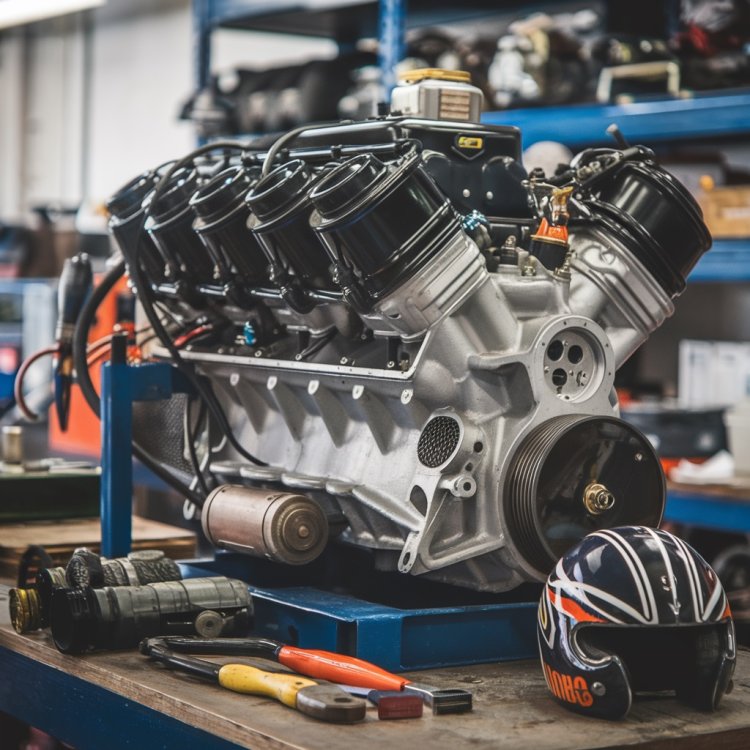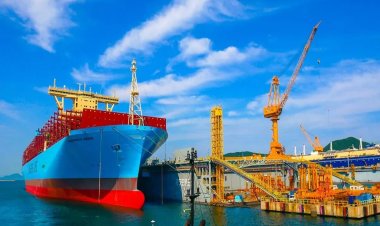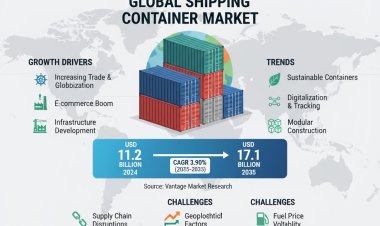Growth Trends and Projections in The High Speed Engine Market
Explore the global high-speed engine market, including growth drivers, regional dynamics, key players, challenges, and future trends. Discover how innovations and market forces are shaping the industry through 2030.

High-Speed Engine Market Analysis 2025-2030: Growth, Trends, and Future Opportunities
The Global High Speed Engine Market is experiencing a period of robust growth, driven by a confluence of technological advancements, rising demand across multiple sectors, and the increasing need for reliable power solutions. According to analysts at Vantage Market Research, the market was valued at USD 20.92 billion in 2022 and is projected to reach USD 29.97 billion by 2030, reflecting a healthy compound annual growth rate (CAGR) of 4.60% over the forecast period. High-speed engines, typically defined as engines operating above 900 revolutions per minute (RPM), are integral to a wide array of applications, including marine propulsion, power generation, railways, and heavy-duty vehicles. Their ability to deliver rapid acceleration, high power output, and operational flexibility makes them indispensable in sectors where performance and reliability are paramount.
Market segmentation reveals a diverse landscape. By application, the market is divided into power generation, marine, railway, and others, with power generation and marine sectors accounting for the largest shares. Fuel type segmentation includes diesel, gas, and dual-fuel engines, with diesel engines currently dominating due to their widespread use and established infrastructure. However, gas and dual-fuel engines are gaining traction, propelled by environmental concerns and regulatory pressures. The end-user segmentation spans commercial, industrial, and residential sectors, with commercial and industrial users leading demand due to their need for backup power and transportation solutions.
Growth drivers for the high-speed engine market are multifaceted. The increasing frequency of power outages, especially in developing regions, has heightened the demand for backup power solutions. Simultaneously, the expansion of maritime tourism and transportation, coupled with rapid urbanization and industrialization, is fueling the need for high-performance engines. However, the market is not without challenges. High operational and maintenance costs, stringent environmental regulations, and supply chain disruptions—exacerbated by the COVID-19 pandemic—pose significant hurdles. Despite these challenges, the market’s outlook remains positive, buoyed by ongoing technological innovation and expanding applications in emerging economies.
Key Takeaways
- The global high-speed engine market was valued at USD 20.92 billion in 2022 and is projected to reach USD 29.97 billion by 2030, growing at a CAGR of 4.60%.
- High-speed engines are essential for applications in power generation, marine, railways, and heavy-duty vehicles due to their rapid acceleration and high power output.
- Rising demand for backup power solutions, especially in regions with unstable grids, is a major driver of market growth.
- Expansion in maritime tourism and transportation is fueling the need for high-performance engines in commercial shipping and cruise industries.
- Urbanization and industrialization, particularly in Asia Pacific, are increasing the demand for high-speed engines in construction, manufacturing, and infrastructure projects.
- Asia Pacific dominates the market share, while North America shows rapid growth potential due to technological advancements and infrastructure investments.
- Key industry players include Caterpillar, Cummins, Rolls-Royce, MAN Energy Solutions, and Wärtsilä, who are focusing on innovation, acquisitions, and hybrid technologies.
- Challenges such as high operational and maintenance costs, stringent environmental regulations, and post-COVID-19 supply chain disruptions are limiting market potential.
- Future opportunities lie in hybrid power generation, digitalization, and rural electrification, with a strong focus on sustainability and alternative fuels.
- The market’s future will be shaped by ongoing innovation, adaptation to environmental standards, and the ability to meet the evolving needs of emerging economies.
Key Growth Factors Driving Market Expansion
Several key factors are propelling the expansion of the high-speed engine market, each contributing to the sector’s sustained growth and resilience. One of the most significant drivers is the rising demand for backup power solutions. As global infrastructure becomes increasingly digitized and dependent on uninterrupted power, the need for reliable backup systems has surged. High-speed engines, with their rapid start-up capabilities and robust performance, are ideally suited for emergency power generation in hospitals, data centers, manufacturing plants, and commercial complexes. This trend is particularly pronounced in regions prone to grid instability and frequent outages, where high-speed engines serve as a critical safeguard against operational disruptions.
The growth of maritime tourism and transportation is another pivotal factor. The global cruise industry, commercial shipping, and offshore operations all rely heavily on high-speed engines for propulsion and auxiliary power. As international trade volumes rise and consumer interest in maritime travel rebounds post-pandemic, the demand for efficient, high-performance engines is expected to climb. High-speed engines offer the agility and reliability required for modern vessels, supporting both passenger comfort and operational efficiency.
Urbanization and industrialization trends further amplify market growth. Rapid urban expansion, especially in Asia Pacific and Africa, is driving the construction of new infrastructure, factories, and transportation networks. High-speed engines are essential for powering construction equipment, locomotives, and industrial machinery, enabling cities and industries to scale efficiently. Additionally, the push for smart cities and advanced manufacturing is creating new opportunities for engine manufacturers to innovate and cater to evolving needs.
Environmental considerations are also shaping market dynamics. While regulatory pressures present challenges, they are simultaneously spurring innovation in engine design and fuel efficiency. Manufacturers are investing in cleaner technologies, such as hybrid and dual-fuel engines, to meet stringent emissions standards and appeal to environmentally conscious customers. This shift not only addresses regulatory requirements but also opens new market segments, particularly in regions with aggressive sustainability goals.
The high-speed engine market’s expansion is underpinned by a combination of rising demand for backup power, the resurgence of maritime activities, and the relentless pace of urbanization and industrialization. These factors, coupled with ongoing innovation and adaptation to environmental imperatives, ensure the market’s continued growth and relevance.
Regional Analysis of Market Dynamics
The high-speed engine market exhibits distinct regional dynamics, with Asia Pacific emerging as the dominant force in terms of market share. The region’s leadership is underpinned by rapid industrialization, urbanization, and infrastructure development, particularly in countries like China, India, and Southeast Asian nations. These economies are investing heavily in transportation networks, manufacturing facilities, and energy infrastructure, all of which require reliable high-speed engines. The burgeoning maritime sector, driven by increased trade and tourism, further bolsters demand. Additionally, government initiatives aimed at improving rural electrification and disaster preparedness are fueling the adoption of backup power solutions, cementing Asia Pacific’s position at the forefront of the market.
North America, while smaller in absolute market share compared to Asia Pacific, is characterized by rapid growth potential. The region benefits from a mature industrial base, advanced technological capabilities, and a strong focus on innovation. The United States and Canada are witnessing increased investments in data centers, healthcare facilities, and critical infrastructure, all of which necessitate robust backup power systems. The resurgence of the oil and gas sector, coupled with the expansion of the logistics and transportation industries, is also driving demand for high-speed engines. Moreover, North America’s proactive approach to environmental regulations is accelerating the adoption of cleaner, more efficient engine technologies, positioning the region as a leader in sustainable engine solutions.
Europe represents a stable and technologically advanced market, with a strong emphasis on sustainability and emissions reduction. The region’s stringent environmental regulations are prompting manufacturers to develop and deploy hybrid and alternative-fuel engines. While growth rates are moderate compared to Asia Pacific and North America, Europe’s focus on innovation and quality ensures a steady demand for high-speed engines, particularly in the marine and rail sectors.
Developing economies in Latin America, the Middle East, and Africa are also making significant contributions to market growth. These regions are characterized by expanding infrastructure projects, increasing energy needs, and a growing emphasis on disaster resilience. High-speed engines are being deployed to support construction, mining, and rural electrification initiatives, providing reliable power in areas with limited grid access. As these economies continue to develop, their demand for high-speed engines is expected to rise, presenting lucrative opportunities for market players.
The regional dynamics of the high-speed engine market are shaped by varying degrees of industrialization, infrastructure development, and regulatory environments. Asia Pacific’s dominance, North America’s innovation-driven growth, and the rising potential of developing economies collectively drive the global market forward.
Major Players and Competitive Landscape
The high-speed engine market is characterized by intense competition and a dynamic landscape, with several key players vying for market share through innovation, strategic partnerships, and acquisitions. Leading companies such as Caterpillar Inc., Cummins Inc., Rolls-Royce Holdings plc, MAN Energy Solutions, and Wärtsilä Corporation dominate the market, leveraging their extensive product portfolios, global distribution networks, and technological expertise. These industry giants are continually investing in research and development to enhance engine performance, fuel efficiency, and emissions compliance, ensuring their products remain at the cutting edge of the market.
Market share is heavily influenced by the ability to offer comprehensive solutions tailored to specific applications. For instance, Caterpillar and Cummins have established strong footholds in the power generation and industrial sectors, while Rolls-Royce and Wärtsilä are renowned for their marine and energy solutions. MAN Energy Solutions, with its focus on large-scale engines for marine and power applications, continues to expand its global presence through strategic collaborations and acquisitions.
Recent years have witnessed a flurry of technological advancements and mergers aimed at consolidating market positions and expanding product offerings. Companies are increasingly focusing on hybrid and dual-fuel engines, digital monitoring systems, and predictive maintenance technologies to meet evolving customer demands and regulatory requirements. The integration of Internet of Things (IoT) and artificial intelligence (AI) into engine management systems is enabling real-time performance monitoring, remote diagnostics, and optimized maintenance schedules, reducing downtime and operational costs.
Strategic acquisitions and partnerships are also shaping the competitive landscape. Major players are acquiring smaller firms with specialized technologies or regional market access to broaden their capabilities and geographic reach. For example, Wärtsilä’s acquisition of Greensmith Energy has strengthened its position in hybrid power solutions, while Cummins’ investment in hydrogen and alternative fuel technologies underscores its commitment to sustainability.
To secure and enhance their market positions, leading companies are adopting a multi-pronged approach. This includes continuous innovation, expansion into emerging markets, and a strong focus on customer service and after-sales support. By offering customized solutions, flexible financing options, and comprehensive maintenance services, these players are building long-term relationships with clients and differentiating themselves in a crowded marketplace.
The high-speed engine market’s competitive landscape is defined by technological innovation, strategic alliances, and a relentless pursuit of operational excellence. The ability to adapt to changing market demands and regulatory landscapes will be crucial for companies seeking to maintain and grow their market share in the years ahead.
Challenges Limiting Market Potential
Despite its promising growth trajectory, the high-speed engine market faces several significant challenges that could constrain its potential. One of the most pressing issues is the high operational and maintenance costs associated with high-speed engines. These engines, while offering superior performance, require regular and often costly maintenance to ensure optimal functionality and longevity. The need for specialized parts, skilled technicians, and frequent servicing can be a deterrent for cost-sensitive customers, particularly in developing regions where budget constraints are more pronounced. Additionally, the total cost of ownership, including fuel consumption and spare parts, can be substantial, impacting the adoption rate among small and medium enterprises.
Stringent environmental regulations represent another formidable challenge. Governments and regulatory bodies worldwide are imposing increasingly strict emissions standards to combat air pollution and mitigate climate change. High-speed engines, especially those powered by diesel, are under scrutiny for their contribution to greenhouse gas emissions and particulate matter. Compliance with these regulations necessitates significant investments in research and development to develop cleaner, more efficient engines. While this drives innovation, it also increases production costs and can delay the introduction of new models to the market. Manufacturers must balance the need for compliance with the imperative to remain competitive on price and performance.
The aftermath of the COVID-19 pandemic has also exposed vulnerabilities in the global supply chain, affecting the availability of critical components and raw materials. Disruptions in logistics, labor shortages, and fluctuating demand have led to delays in production and delivery, impacting both manufacturers and end-users. The reliance on global supply networks means that any disruption—whether due to geopolitical tensions, natural disasters, or health crises—can have far-reaching consequences for the high-speed engine market. Companies are now reevaluating their supply chain strategies, seeking to diversify suppliers and increase inventory buffers to mitigate future risks.
Furthermore, the transition towards alternative energy sources poses a long-term challenge to the traditional high-speed engine market. The growing adoption of renewable energy, battery storage, and electrification in transportation and power generation threatens to erode demand for conventional engines. While high-speed engines will continue to play a vital role in specific applications, particularly where rapid response and high power are required, manufacturers must innovate to remain relevant in an evolving energy landscape.
The high-speed engine market must navigate a complex array of challenges, from high operational costs and regulatory pressures to supply chain disruptions and the rise of alternative energy. Addressing these issues will require a concerted effort from industry stakeholders, including investment in innovation, supply chain resilience, and sustainable practices.
Future Opportunities and Trends
Looking ahead, the high-speed engine market is poised for transformation, driven by emerging opportunities and technological trends that promise to reshape the industry. One of the most exciting developments is the innovation in hybrid power generation. As the world transitions towards cleaner energy sources, hybrid systems that combine high-speed engines with renewable energy and battery storage are gaining traction. These systems offer the flexibility and reliability of traditional engines while reducing emissions and fuel consumption. Hybrid power solutions are particularly attractive for remote locations, islands, and off-grid applications, where grid connectivity is limited or unreliable.
Emerging technologies in the transportation sector are also creating new avenues for growth. The integration of digital technologies, such as IoT, AI, and advanced analytics, is revolutionizing engine management and maintenance. Predictive maintenance, enabled by real-time data monitoring, allows operators to anticipate and address issues before they lead to costly breakdowns, enhancing operational efficiency and reducing downtime. Additionally, advancements in materials science and manufacturing processes are enabling the development of lighter, more durable, and fuel-efficient engines, further expanding their applicability across sectors.
The potential for expansion in rural electrification represents a significant opportunity, particularly in developing regions. High-speed engines, either as standalone generators or as part of hybrid microgrids, can provide reliable power to communities that lack access to centralized electricity. Governments and development agencies are increasingly investing in rural electrification projects, recognizing the role of reliable power in driving economic growth, education, and healthcare. Engine manufacturers that can offer cost-effective, scalable, and environmentally friendly solutions stand to benefit from this growing market segment.
Sustainability will remain a central theme in the future of the high-speed engine market. The push towards decarbonization is prompting manufacturers to explore alternative fuels, such as hydrogen, biofuels, and synthetic fuels, which can significantly reduce the carbon footprint of high-speed engines. Collaborative efforts between industry players, research institutions, and governments are accelerating the development and deployment of these technologies, paving the way for a more sustainable and resilient energy future.
In summary, the high-speed engine market is on the cusp of significant change, driven by innovations in hybrid power, digitalization, and sustainable technologies. By embracing these trends and capitalizing on emerging opportunities, industry stakeholders can ensure continued growth and relevance in a rapidly evolving global landscape.
FAQs
- What factors are driving the growth of the Global High Speed Engine Market?
- How is the market projected to change from 2022 to 2030?
- What is the expected CAGR for the Global High Speed Engine Market during the forecast period?
- What was the market value of the Global High Speed Engine Market in 2022?
☎ Contact Us:
224 W 35th St Ste 500 New York,
USA/Canada Toll Free +1(877) 462-2282
+1(212) 951-1369
✉ Email: [email protected]
???? Website: https://www.vantagemarketresearch.com


















